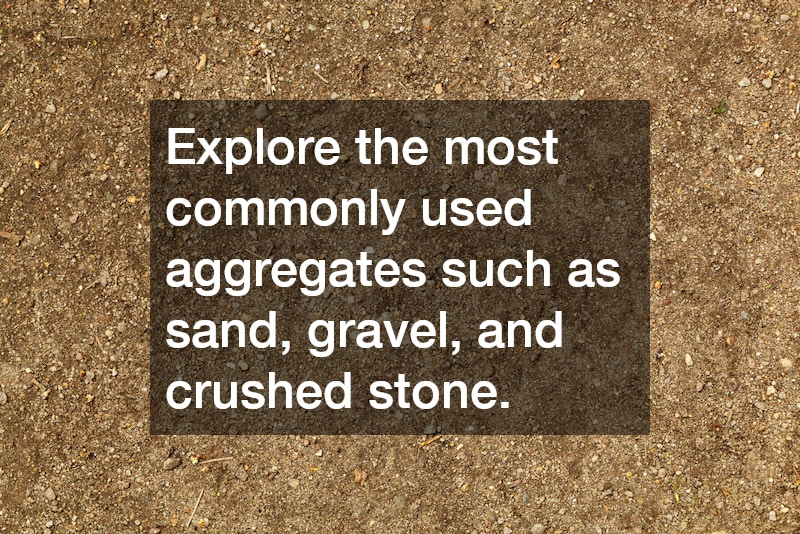
How to Choose the Right Aggregate Type When You Buy Aggregates for Your Project
Understanding the role of aggregates in construction projects is crucial for ensuring success. This article will guide you through the process of choosing the right aggregate type to meet the requirements of your specific project.
What Types of Aggregates Are Available and What Are Their Uses?
Common Types of Aggregates
Explore the most commonly used aggregates such as sand, gravel, and crushed stone, along with their primary applications in construction projects. Sand is widely used in concrete production, acting as a foundation or filler, while gravel is often used in road construction due to its durability and stability.
Crushed stone acts as an essential component in road and rail-track beds due to its strength and compactness. These aggregates not only provide a stable base but also help distribute loads uniformly across the structure.
The fact remains that the choice of aggregate can significantly impact the longevity and strength of the construction. As such, each project’s unique requirements should guide the selection of the aggregate type.
Specialty Aggregates and Their Applications
Learn about specialty aggregates, including recycled aggregates and lightweight options, and how they can be used in specific projects. Recycled aggregates offer an eco-friendly alternative, helping to reduce the carbon footprint in modern construction projects.
Lightweight aggregates, formed from expanded clay or shale, are used in places requiring lower structural weight, such as high-rise buildings or bridges. Their innovation has led to more sustainable practices in construction by reducing the amount of raw material extraction needed.
It is important to consider specialized aggregates, as they can cater to particular needs such as enhanced thermal insulation or improved aesthetic finishes. This ensures that specific project goals are met effectively.
How Do You Determine the Right Aggregate Size for Your Project?
Factors Affecting Aggregate Size Selection
Discover key factors such as project type, load requirements, and environmental conditions that influence the choice of aggregate size. Larger aggregates can provide additional strength to structures, making them ideal for heavy load-bearing projects.
In contrast, finer aggregates offer a smoother finish, which is suitable for projects like plaster or architectural details. Environmental factors like temperature and moisture levels also play a crucial role, as they can affect the aggregate’s performance over time.
Contractors must analyze these factors comprehensively to ensure the selected aggregate size aligns with the project’s technical specifications. Doing so guarantees structural integrity and longevity.
Tools and Methods for Size Selection
Get insights into the tools and methods used by professionals to select the appropriate aggregate size for various construction needs. Sieving and screening are common methods that help in determining and categorizing aggregate sizes.
Electronic tools and software now exist that allow for precision in selecting aggregate sizes, which optimizes the material’s intended performance. These tools aid in achieving cost-efficiency while maximizing construction quality.
Ultimately, utilizing the correct methodology in size selection contributes significantly to ensuring the desired structural performance. It further minimizes the risk of potential errors or material wastage.
What Should You Consider When Choosing an Aggregate Supplier?
Evaluating Supplier Reputation and Reliability
Identify criteria to assess the reputation and reliability of aggregate suppliers to ensure quality products for your project. A supplier’s reputation is often built upon their quality of service, reliability of delivery, and consistency in supplying high-grade materials.
Online reviews, industry awards, and feedback from other contractors can serve as valuable resources in making an informed decision. It’s crucial to collaborate with a supplier who values transparency and timely communication.
Building a relationship with a reliable supplier assures a seamless flow of materials without the risk of unexpected delays. This is essential in maintaining project timelines and managing costs effectively.
Assessing Cost and Availability
Understand how to evaluate cost considerations and availability when choosing a supplier to avoid project delays and budget overruns. Cost assessments should not only account for the price of the material but also consider delivery charges and potential wastages.
Availability is equally critical, as unreliable supply chains can lead to costly project downtimes. Suppliers with high stock levels generally provide better resource distribution across multiple or large-scale projects.
Considering both cost and availability helps in creating a strategic procurement plan that aligns with the project’s budget and timeline. It underscores the importance of selecting a supplier who can maintain a steady supply of high-quality aggregates.
Conclusion
Making informed decisions about aggregate types is essential for the success of your construction project. By considering the factors discussed in this article, you can confidently select the right aggregates and suppliers to meet your project’s needs.





